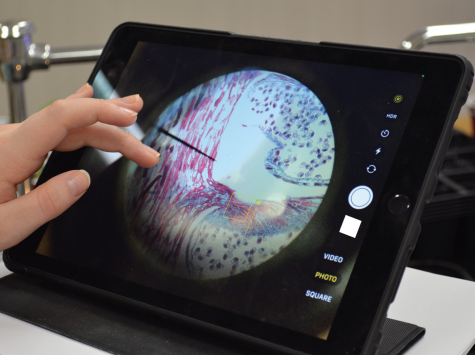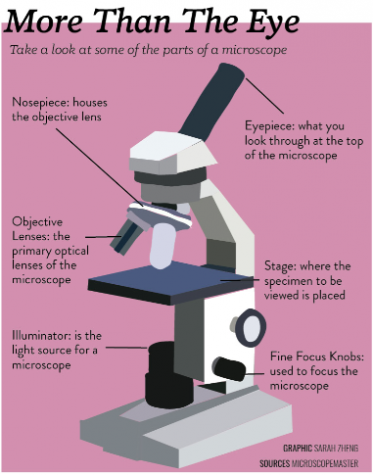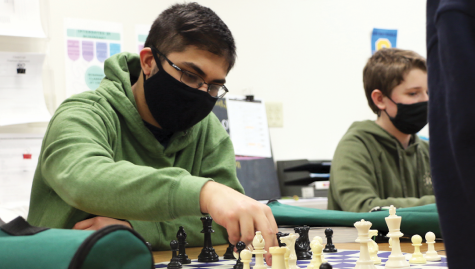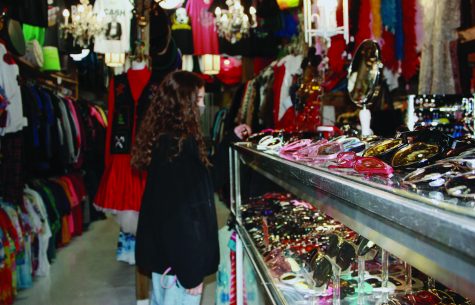Magnifying Microbes
CHS science teachers, students share experiences conducting experiments during COVID-19 pandemic

Lindsay Vrobel, botany student and senior, focuses the iPad to view the contents under the microscope. Due to COVID-19, botany students have been using iPads to view the microscope, as opposed to directly looking through the eyepiece.
Similarly to how Alice falls into a new world when she looks through a mirror in Lewis Carroll’s 1871 fantasy novel, “Through the Looking-Glass”, senior Lindsay Vrobel said she is always amazed when she looks through a microscope.
However, with the COVID-19 pandemic, Vrobel said something as simple as looking through a microscope has now become a challenging task.
“(In botany) we did an onion lab where we were supposed to be able to look at the cells of an onion through a microscope,” Vrobel said. “We propped an iPad against a microscope and viewed it under the projector which reduced the quality of what we were seeing. It made it a lot harder to see the organelles of the cell which makes it a lot more tough to see and understand the cell structure.”
Vrobel is not the only student who has had difficulties conducting labs with restrictions caused by the COVID-19 pandemic. Eric Guo, AP Chemistry student and sophomore, said he has had challenges adjusting as well.
“With in-person labs, everyone has to wash their hands and keep their masks on and maintain social distancing. We had more strict time-limits since we could not stay within six feet of each other for more than fifteen minutes,” Guo said. “We would also always get worksheets, but a lot of times I would find that people would not be able to get the worksheets done during the actual lab time, so we would have to do the worksheets on our virtual days rather than completing the worksheet as we were doing the lab due to time restrictions.”

Additionally, Guo said now that he is a virtual student he has had to face new challenges when performing labs.
“Our teacher takes a video of her doing the labs, and we do the worksheet that comes with the labs. So we watch the videos and we do the worksheet,” he said. “To be completely honest, I don’t really like this way of doing labs because it is just not as interesting as doing the labs yourself. Also, I don’t blame my teacher for this because it’s hard to fill and do the labs at the same time, but a lot of measurements are not as clear and oftentimes the reactions are harder to see.”
Science teacher James Hambley said he acknowledges the difficulty of the current situation, however, he said he has found a silver lining when it comes to science experiments.
“During zoology, it is really hard to get a dissection completed in less than 15 minutes,” he said. “What I have been doing is setting up rotations where you don’t get more than 15 minutes next to any particular person. So it changed it in that instead of working on one specimen, some students were jumping between one specimen to another one and that made their new partner catch them up on anything different. Some individuals went from dissecting a male rat and then during the next rotation they are dissecting a female rat and would have to be caught up quickly by their new partner.”
However, Hambley said that this structure may have been a blessing in disguise.
“When students have to explain where they are at in the dissection and what parts they have already identified to somebody coming to the group it kind of forces them to be thinking about how they are going to explain it to somebody who is being added during the next rotation,” he said. “I wasn’t expecting it because it just seemed like the traditional way where you and your group are with one specimen the whole time seemed to work well.”

Lindsay Vrobel, botany student and senior, uses the new microscope set up. The iPad was elevated on textbooks and held up with a block, which lets Vrobel to look at a slide of a plant cell through the iPad without touching the microscope.
Hambley said he tries to find some labs students can still perform at home. For example, he had students in his botany class conduct a soil texture lab where they analyzed the amount of clay, silt and soil in their own backyards.
“Even though they were at home trying to do it virtually (the experiment) worked for some students and it just didn’t work for other students, which I think that is kind of how virtual has been going,” Hambley said. “Some students can roll with it. And for some students, it’s just this insurmountable barrier that is just really getting in the way of their education.”
Science department chairperson Jennifer Drudge said, “It’s been challenging this year to figure out labs that we have done in the past that may have been 60-minute or 90 (-minute) labs or perhaps of labs that have gone over the course in a couple of days and figure out how to incorporate those in the classroom. We know that students need to be active in their learning. We know that these labs are really important, but at the same time, we need to maintain social distancing, which has been tricky.”
Vrobel said, “Honestly, (teachers) are doing the best they can. If I would have to say anything it would be for teachers to designate students with a lab partner. If they get sick you quarantine and you just got one person you work with on your labs and you can work with them the entire time and they are just your one person.”





